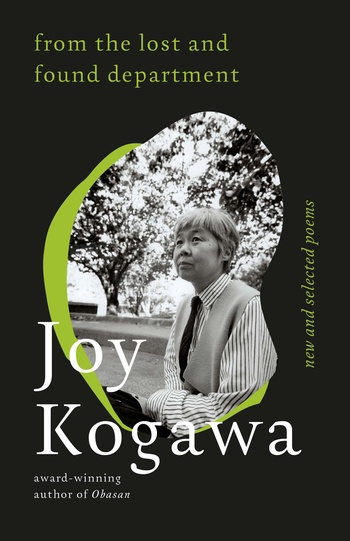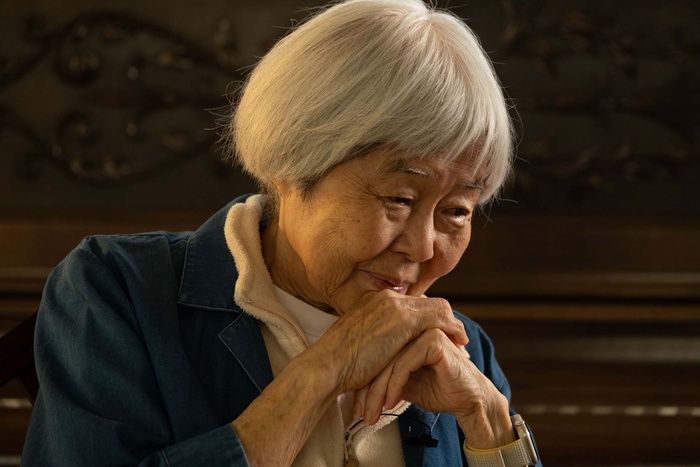At 88, author and activist Joy Kogawa proclaim sher latest book of poetry, From the Lost and Found Department: new and selected poems, to be her “last hurrah, thanks be.”
And if it turns out to be her final one (though I’m told she’s still writing articles…) inadvertently, she may propel the next generation of Nikkei poets further along and to follow in her wake. With her nearly 60 years of publishing, Kogawa has consistently written about life as a postwar Nisei Canadian, its post-traumatic fallout and unintended consequences. It is a path she has clear-cut so others may follow her lead and proceed with fewer impediments.
During the expanse of her literary career from 1967 to 2023, Kogawa has written 15 books: eight poetry collections, three novels, two memoirs, and two for children (plus an augmented reality game). Beyond sharing her experience as a Japanese Canadian woman living in these modern times, she has shown how to live compassionately as a daughter, wife, mother, friend, ally, and now as an elder.
In Kogawa’s 93 newest poems, her range of topics remain vast— from the specific: observing a fattened spider on her window ledge at night capturing winged insects seeking her indoor light; to the cosmic: those on turbulent seas, stars direct…align with north star; and even the ethereal: how an angel can be made by moving out of the darkness.
Themes:

Her themes are as broad as they are deep. The religious: sharing blest bread on life’s long journey. The political: bureaucrats may kill, more than they save. The musical: a cellist bow’s utterances dissolving city’s walls. And her longing and loss experienced: for forgiveness as a final taste of water…my mother my father my brother wait with me for the place without enemies. Always the ever-present revelatory power of nature: all life is grass as it sprouts up wet green from the concrete land of Toronto. Plus, most recently, Kogawa delves into aging: let’s not rush to retirement homes…our limbs, less limber less spritely though, not yet brittle not yet.
Peppered throughout, Kogawa has written innumerable tributes and elegies to friends, family, and people from the well-known to unknown to the alive and departed: Mozart, Zorba the Greek, a Homeless man, Barry Kermit Gostlin. And there are countless others to whom she pays homage: Aiko to Maryka to Yoshiko, our morning star, she of the kindest of stars. Plus, so many more in-between.
Why did Kogawa choose the title From the Lost and Found Department for her last book of poetry? In her opening poem, she writes though things, names, and friends may get lost throughout a lifetime, what she found integrity is, lost neither by, deluge nor judgment.
Selected Poems:
Kogawa’s 338-page tome combines her 93 new poems in From the Lost and Found Department with selected works from five of her previous poetry books. Given the many reviews of each, I will only summarize them here:
The Splinter Moon (1967), 18 poems, centres on the demise of her marriage from despair in Help Me Someone to knowing it is past repair in In Memory: I try to be kind And kill the weeds and nourish the flower Because you are dead Because you must be dead.
A Choice of Dreams (1974), 76 poems, reflects her first trip to Japan in 1969 and the dissonant feelings of a Nikkei travelling one’s ancestral homeland for the first time. Kogawa explores the transformation of the self where one blends into the ‘invisible majority’ after a life spent contending to being a ‘visible minority’ in a predominately white Canadian culture. She simultaneously senses the awkwardness of not speaking Japanese fluently nor fully comprehending the local cultural mores. In Saturday Night in Osaka: With my Japanese face in my dragon lady disguise, English like a dagger in my teeth, …And for the rest of the evening, Thumb through a Japanese-English dictionary.
Jericho Road (1977), 88 poems, divided into two parts tracing the poet’s travails through her 40s midlife crisis from her work to the dissolution of her marriage.
Woman in the Woods (1985), 60 poems, is divided into three sections. For David: she tracks and arrives at a place of closure with her former husband. She Flees: Kogawa probes her journey made after ending her 11-year marriage. In the Woods: where she revisits the lingering legacy of her experiences during the Second World War in Coaldale Poem: Your black-winged puritans, tell me how I may not live, or write of love.
Selections from a Garden of Anchors (2003), four poems, the longest dedicated to her dear deceased friend: we come, that busiest place of the holiest one, in the journey to death that is wholly undone.
Conclusion:
What this reader is left with after reading and reflecting upon Kogawa’s corpus of 344 poems is an overall haunting and elegiac tone of wistfulness. In her “last hurrah,” I was once again left with her having given voice to the voiceless and spoken back to the silence that cannot speak—thanks be!
* * * * *
Special thanks to: Kelly Fleck, Editor of the Nikkei Voice, for her guidance in writing this article.
For more information on Joy Kogawa and her book, please see “Joy Kogawa” (The Canadian Encyclopedia) and the publisher Penguin Random House.
*This article was originally published in The Nikkei Voice on March 2024 issue.
© 2024 Catherine Jo Ishino





